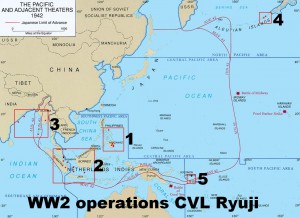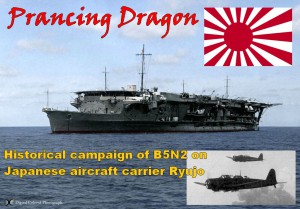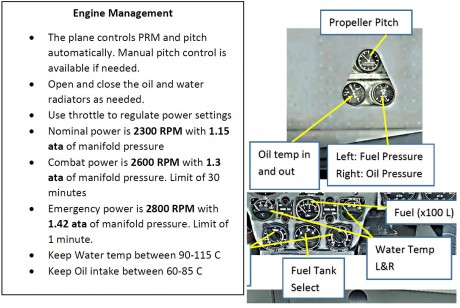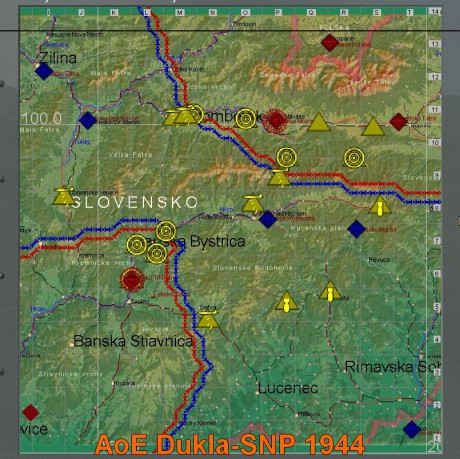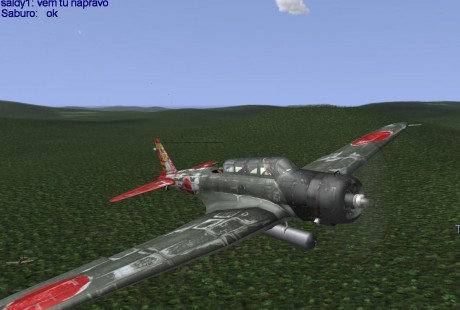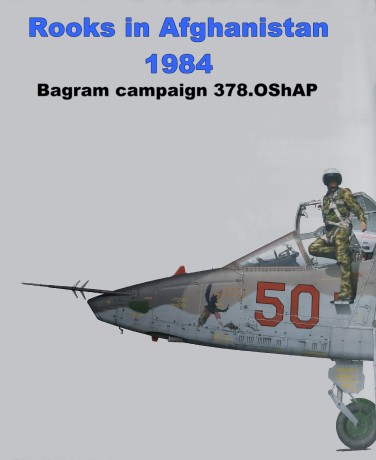Prancing Dragon 1941-42
DOWNLOAD v.1.1
http://www.mission4today.com/index.php?name=Downloads3&file=details&id=2077
Tak přátelé Pacifiku !, v současnosti dělám na kampani pro B5N Kate. Dlouho jsem hledal a sbíral materiály a lámal si hlavu kam to celé zarámovat. Děsil jsem se prostě stavby velkých námořních bitev ani jsem nechtěl zůstat jen na souši, protože Kate je především námořní letoun kde jde o dolet v první řadě, a tomu je u něj vše podřízeno. Nakonec jsem si proklepnul japonské CVL a velmi mile mě překvapilo pestré bojové nasazení CVL Rjúdžo, tedy druhého japonského nosiče stavěného od počátku jako letadlová loď.
Raid on Malalag
7.12.41
-----------------
The ship's assignment at the beginning of the Pacific War was to support the
invasion of the Philippines, initially by attacking the American naval base at
Davao, Mindanao on the morning of 8 December. Her air group had not
changed, but four of each type of aircraft were spares. Ryūjō 's initial airstrike
consisted of 13 B5Ns escorted by nine A5Ms with a smaller, follow-on airstrike
later in the day by two B5Ns and three A5Ms. They accomplished little,
destroying two Consolidated PBY seaplanes on the ground for the loss of one
B5N and A5M. The ship covered the landing at Davao on 20 December and her
B5Ns attacked a British oil tanker south of Davao. In January 1942 her aircraft
supported Japanese operations in the Malay Peninsula
Target:
The war began. The enemy has his troops in the Gulf Malalag, unfortunately we
do not know what awaits us here. Explore with your squadron area and destroy
everything you can find.
Raid on Davao
7.12.41
------------------------
Target:
The second wave of bombers destroyed the fuel tank in Davao
Raid on radio station
19.12.41
------------------------
Target:
Destroy radio station on cape of San Augustin
Raid on tanker near Mindanao
20.12.41
---------------------
Target
search and destroy enemy tanker sailing from Davao
Raid on Singapore airfield
18.1.42
---------------------------------
In mid-February 1942, Ryūjō 's aircraft attacked ships evacuating from Singapore,
claiming eight ships damaged, three burnt, and four sunk. They also covered
convoys carrying troops to Sumatra. The ship was unsuccessfully attacked by
several Bristol Blenheim light bombers of No. 84 Squadron RAF on 14 February.
The following day two waves of B5Ns, totaling 13 aircraft, attacked the British
heavy cruiser Exeter, but only managed to damage the ship's Supermarine
Walrus seaplane. Follow-on attacks later that day were also unsuccessful. Two
days later, B5Ns destroyed HNLMS Van Ghent, a Dutch destroyer that had run
aground in the Gaspar Strait and been abandoned on 14 February. The carrier
sailed to Saigon, French Indochina the next day and arrived on 20 February. A
week later she was assigned to cover the convoy taking troops to Jakarta, Java.
Her aircraft participated in the Second Battle of the Java Sea on 1 March and six
B5Ns sank the American destroyer Pope after it had been abandoned by its
crew. Six other B5Ns bombed the port of Semarang, possibly setting one
merchantman on fire.
Target:
Destroy enemy equipment on airfield
Raid on Pelembang
10.2.42
------------------------
Target:
Destroy train station in Pelembang city
Raid on Singapore port
13.2.42
------------------------
Target:
Destroy enemy equipment or ships in Singapore port
Raid on ships escaped from Singapore
14.2.42
---------------------
Target:
British troops cowardly retreat from Singapore. Destroy fleeing ships.
Raid on ABDA squadron
15.2.42
-------------
Target:
Search and destroy enemy group of war ships
Raid on USS Pope
29.2.42
--------------------
Target:
Search and destroy enemy destroyer retreating from battle.
Raid on SS Sinabang
2.3.42
---------------------------
Target:
Search and destroy enemy cargo ship
Raid on enemy forces in Burma
20.3.42
---------------------------------
Ryūjō arrived in Singapore on 5 March and the ship supported operations in
Sumatra and escorted convoys to Burma and the Andaman Islands for the rest of
the month. On 1 April, while the 1st Air Fleet was starting its raid in the Indian
Ocean, Malay Force, consisting of Ryūjō, six cruisers, and four destroyers, left
Burma on a mission to destroy merchant shipping in the Bay of Bengal. B5Ns
damaged one freighter on 5 April before the force split into three groups. Ryūjō
's aircraft bombed the small ports of Cocanada and Vizagapatam on the
southeastern coast of India the next day, doing little damage, in addition to
claiming two ships sunk and six more damaged during the day. The carrier and
her escorts, the light cruiser Yura and the destroyer Yugiri claimed to have sunk
three more ships by gunfire. All together, Malay Force sank 19 ships totaling
almost 100,000 gross register tons (GRT), before reuniting on 7 April and arriving
at Singapore on 11 April. A week later, her B5Ns were detached for torpedo
training and the ship arrived at Kure on 23 April for a brief refit.
Target:
Support our ground troops. Destroy the enemy defensive positions
Raid on convoy near India
5.4.42
--------------------
Target:
Sink enemy ships
Raid on convoy near India
6.4.42
--------------------
Target:
Sink enemy ships
Raid on Visakhapatnam
7.4.42
-------------------------------
Target:
Destroy enemy equipment or ships in Visakhapatnam port
Raid on Dutch Harbor
3.6.42
-------------------------
The newly commissioned carrier Jun'yō joined Carrier Division 4, under the
command of Kakuta, with Ryūjō on 3 May 1942. They formed the core of the 2nd
Carrier Strike Force, part of the Northern Force, tasked to attack the Aleutian
Islands, an operation planned to seize several of the islands to provide advance
warning in case of an American attack from the Aleutians down the Kurile
Islands while the main body of the American fleet was occupied defending
Midway. Ryūjō 's air group now consisted of 12 A6M2 Zeros and 18 B5Ns, plus
two spares of each type. The ship transferred to Mutsu Bay on 25 May and then
to Paramushiro on 1 June before departing the same day for the Aleutians.
At dawn on 3 June, she launched nine B5Ns, escorted by six Zeros, to attack
Dutch Harbor on Unalaska Island. One B5N crashed on takeoff and only six of
the B5Ns and all of the Zeros were able to make it through the bad weather,
destroying two PBYs and inflicting significant damage on the oil storage tanks
and barracks. A second airstrike was launched later in the day to attack a group
of destroyers discovered by aircraft from the first attack, but they failed to find the
targets. One Zero from Ryūjō from the second strike was damaged by a Curtiss
P-40 and crash landed on the island of Akutan. The aircraft, later dubbed the
Akutan Zero, remained largely intact and was later salvaged and test-flown.
Another airstrike was launched on the following day by the two carriers that
consisted of 15 Zeros, 11 D3As, and 6 B5Ns and successfully bombed Dutch
Harbor. Shortly after the aircraft were launched, the Americans attacked the
carriers, but failed to inflict any damage. A Martin B-26 Marauder bomber and a
PBY were shot down by Zeros, and a Boeing B-17 Flying Fortress bomber was
shot down by flak during the attack.
Ryūjō arrived back at Mutsu Bay on 24 June, but departed for the Aleutians four
days later to cover the second reinforcement convoy to Attu and Kiska Islands
and remained in the area until 7 July in case of an American counterattack. She
arrived at Kure on 13 July for a refit and was transferred to Carrier Division 2 a
day later.
Raid on Dutch Harbor II. 4.6.42
Raid on Lunga Point
24.8.42
------------------------------
The American landings on Guadalcanal and Tulagi on 7 August caught the
Japanese by surprise. The next day, Ryūjō was transferred to Carrier Division 1
and departed for Truk on 16 August together with the other two carriers of the
division, Shōkaku and Zuikaku. Her air group consisted of 24 Zeros and nine
B5N2s. Admiral Isoroku Yamamoto, commander-in-chief of the Combined Fleet,
ordered Truk to be bypassed and the fleet refueled at sea after an American
carrier was spotted near the Solomon Islands on 21 August. At 01:45 on 24
August, Vice Admiral Chūichi Nagumo, commander of the Mobile Force,
ordered Ryūjō and the heavy cruiser Tone, escorted by two destroyers,
detached to move in advance of the troop convoy bound for Guadalcanal and to
attack the Allied air base at Henderson Field if no carriers were spotted. This
Detached Force was commanded by Rear Admiral Chūichi Hara in Tone.
Ryūjō launched two small airstrikes, totaling six B5Ns and 15 Zeros, beginning at
12:20 once the Diversionary Force was 200 nautical miles (370 km; 230 mi) north
of Lunga Point. Four Grumman F4F Wildcat fighters from Marine Fighter
Squadron VMF-223 on combat air patrol (CAP) near Henderson Field spotted
the INCOMING Japanese aircraft around 14:20 and alerted the defenders. Ten
more Wildcats from VMF-223 and VMF-212 scrambled, as well as two United
States Army Air Corps Bell P-400s from the 67th Fighter Squadron in response.
Nine of the Zeros strafed the airfield while the B5Ns bombed it with 60-kilogram
(130 lb) bombs to little effect. The Americans claimed to have shot down 19
aircraft, but only three Zeros and three B5Ns were lost, although another B5N
was forced to crash-land. Only three Wildcats were shot down in turn.
Around 14:40, the Detached Force was spotted again by several search aircraft
from the carrier USS Enterprise, although the Japanese ships did not
immediately spot the Americans. They launched three Zeros as CAP at 14:55,
shortly before two of the searching Grumman TBF Avenger torpedo bombers
near-missed Ryūjō 150 meters (490 ft) astern with four 500-pound (230 kg)
bombs three minutes later. Two more Zeros reinforced the CAP shortly after
15:00, just in time to intercept two more searching Avengers, shooting down
one. In the meantime, the carrier USS Saratoga had launched an airstrike
against the Detached Force in the early afternoon that consisted of 31 Douglas
SBD Dauntlesses and eight Avengers; the long range precluded fighter escort.
They sighted the carrier shortly afterward and attacked. They hit Ryūjō three
times with 1,000-pound (450 kg) bombs and one torpedo; the torpedo hit
flooded the starboard engine and boiler rooms. No aircraft from either Ryūjō or
Saratoga were shot down in the attack.
The bomb hits set the carrier on fire and she took on a list from the flooding
caused by the torpedo hit. Ryūjō turned north at 14:08, but her list continued to
increase although the fires were put out. The progressive flooding disabled her
machinery and caused her to stop at 14:20. The order to abandon ship was
given at 15:15 and the destroyer Amatsukaze moved alongside to rescue the
crew. The ships were bombed several times by multiple B-17s without effect
before Ryūjō capsized about 17:55 with the loss of 7 officers and 113 crewmen.
Mission UPDATED to 1.1
http://www.mission4today.com/index.php?name=Downloads3&file=details&id=2077
